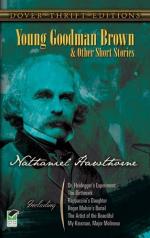|
This section contains 6,287 words (approx. 21 pages at 300 words per page) |

|
SOURCE: "The Reader in 'Young Goodman Brown'," in The Nathaniel Hawthorne Journal 1975, edited by C. E. Frazer Clark, Jr., Microcard Editions Books, 1975, pp. 156-69.
In this essay, Liebman argues that Hawthorne's concern in "Young Goodman Brown" is to challenge the reader's own morality and to force the reader to choose between conflicting possibilities of meaning.
Like "My Kinsman, Major Molineux" and "The Maypole of Merry Mount," "Young Goodman Brown" begins at dusk, and the journey on which its hero embarks is ventured among diminishing lights and growing shadows which signify a world of moral uncertainty and announce the coming of a moral crisis. In "the heart of the dark wilderness," as in so many of Hawthorne's stories, a young man is given the opportunity to see nature as it really is, illuminated by no lights other than its own and observed by his eyes only. Like Reuben Bourne...
|
This section contains 6,287 words (approx. 21 pages at 300 words per page) |

|


